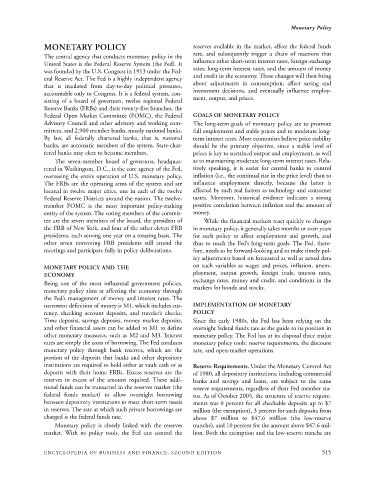Page 538 - Encyclopedia of Business and Finance
P. 538
eobf_M 7/5/06 3:15 PM Page 515
Monetary Policy
MONETARY POLICY reserves available in the market, affect the federal funds
rate, and subsequently trigger a chain of reactions that
The central agency that conducts monetary policy in the
United States is the Federal Reserve System (the Fed). It influence other short-term interest rates, foreign-exchange
was founded by the U.S. Congress in 1913 under the Fed- rates, long-term interest rates, and the amount of money
and credit in the economy. These changes will then bring
eral Reserve Act. The Fed is a highly independent agency
about adjustments in consumption, affect saving and
that is insulated from day-to-day political pressures,
accountable only to Congress. It is a federal system, con- investment decisions, and eventually influence employ-
sisting of a board of governors, twelve regional Federal ment, output, and prices.
Reserve Banks (FRBs) and their twenty-five branches, the
Federal Open Market Committee (FOMC), the Federal GOALS OF MONETARY POLICY
Advisory Council and other advisory and working com- The long-term goals of monetary policy are to promote
mittees, and 2,900 member banks, mostly national banks. full employment and stable prices and to moderate long-
By law, all federally chartered banks, that is, national term interest rates. Most economists believe price stability
banks, are automatic members of the system. State-char- should be the primary objective, since a stable level of
tered banks may elect to become members. prices is key to sustained output and employment, as well
The seven-member board of governors, headquar- as to maintaining moderate long-term interest rates. Rela-
tered in Washington, D.C., is the core agency of the Fed, tively speaking, it is easier for central banks to control
overseeing the entire operation of U.S. monetary policy. inflation (i.e., the continual rise in the price level) than to
The FRBs are the operating arms of the system and are influence employment directly, because the latter is
located in twelve major cities, one in each of the twelve affected by such real factors as technology and consumer
Federal Reserve Districts around the nation. The twelve- tastes. Moreover, historical evidence indicates a strong
member FOMC is the most important policy-making positive correlation between inflation and the amount of
entity of the system. The voting members of the commit- money.
tee are the seven members of the board, the president of While the financial markets react quickly to changes
the FRB of New York, and four of the other eleven FRB in monetary policy, it generally takes months or even years
presidents, each serving one year on a rotating basis. The for such policy to affect employment and growth, and
other seven nonvoting FRB presidents still attend the thus to reach the Fed’s long-term goals. The Fed, there-
meetings and participate fully in policy deliberations. fore, needs to be forward-looking and to make timely pol-
icy adjustments based on forecasted as well as actual data
MONETARY POLICY AND THE on such variables as wages and prices, inflation, unem-
ployment, output growth, foreign trade, interest rates,
ECONOMY
exchange rates, money and credit, and conditions in the
Being one of the most influential government policies,
monetary policy aims at affecting the economy through markets for bonds and stocks.
the Fed’s management of money and interest rates. The
narrowest definition of money is M1, which includes cur- IMPLEMENTATION OF MONETARY
rency, checking account deposits, and traveler’s checks. POLICY
Time deposits, savings deposits, money market deposits, Since the early 1980s, the Fed has been relying on the
and other financial assets can be added to M1 to define overnight federal funds rate as the guide to its position in
other monetary measures, such as M2 and M3. Interest monetary policy. The Fed has at its disposal three major
rates are simply the costs of borrowing. The Fed conducts monetary policy tools: reserve requirements, the discount
monetary policy through bank reserves, which are the rate, and open-market operations.
portion of the deposits that banks and other depository
institutions are required to hold either as vault cash or as Reserve Requirements. Under the Monetary Control Act
deposits with their home FRBs. Excess reserves are the of 1980, all depository institutions, including commercial
reserves in excess of the amount required. These addi- banks and savings and loans, are subject to the same
tional funds can be transacted in the reserves market (the reserve requirements, regardless of their Fed member sta-
federal funds market) to allow overnight borrowing tus. As of October 2005, the structure of reserve require-
between depository institutions to meet short-term needs ments was 0 percent for all checkable deposits up to $7
in reserves. The rate at which such private borrowings are million (the exemption), 3 percent for such deposits from
charged is the federal funds rate. above $7 million to $47.6 million (the low-reserve
Monetary policy is closely linked with the reserves tranche), and 10 percent for the amount above $47.6 mil-
market. With its policy tools, the Fed can control the lion. Both the exemption and the low-reserve tranche are
ENCYCLOPEDIA OF BUSINESS AND FINANCE, SECOND EDITION 515

